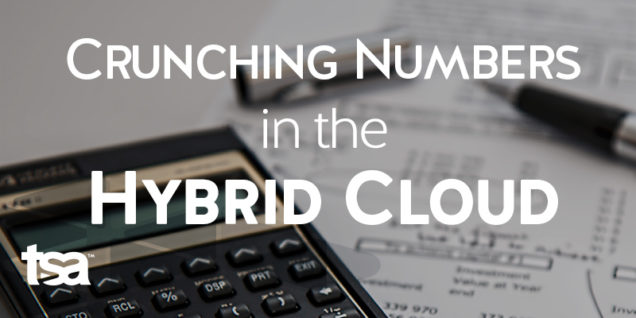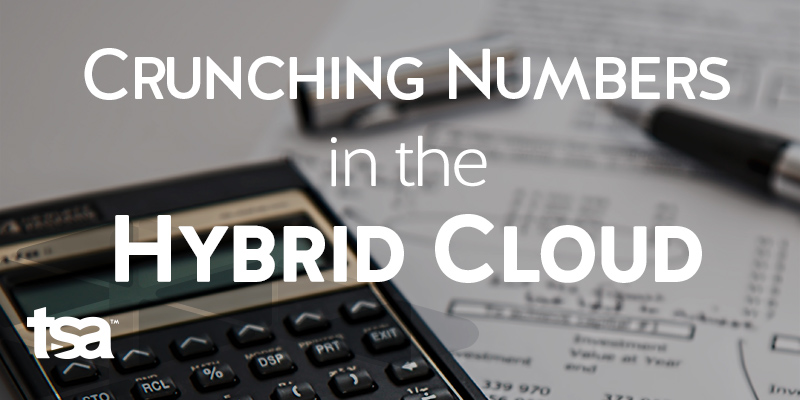“There were all these myths flying around about the public cloud becoming a commodity … [but] If you have engineers that are really good at running your private cloud and the cloud is highly utilized over its lifetime, in those cases, it is cheaper than public cloud. … Conversely, when not well used and managed, an OpenStack private cloud will cost more than public cloud.” – Owen Rogers, 451 Research
In the second installment of our hybrid cloud series, we helped you answer the big question: to [hybrid] cloud or not to cloud? If your verdict on that question ended in either a tentative or a resounding yes—but you’d still like to see some numbers—this third installment is for you. As we cautioned before, a hybrid cloud environment might not be the right fit for your company right now, so rushing into a new migration can spell folly for the under-informed investor. If you missed it or need a refresher course, go check out our pre-migration advice.
Many people have made the assumption that a transition to hybrid technologies automatically equals money in the bank, but, as you’ll see, that’s not always the case. Well, enough chit chat; let’s talk data, apps, and money and how to keep more of the green stuff in the bank where it belongs.
Crunch Time
We hate to say it, but we’re starting off immediately with a bit more research and analytics. Though, as always, we’re here to walk with you through the hard parts. As you may have assumed, not all applications take full advantage of the cloud, and not all data is best kept in cloud storage.
If the shoe doesn’t fit, don’t wear it.
Moving your assets to cloud may cost you more than before, but when does that happen? Let’s figure out which option is best for you.
On-Premises or a Jump to Cloud? (Taking Full Advantage of Cloud)
Let’s start by exploring the financial ramifications of on-premises versus cloud-based migration.
This decision is crucial. In fact, an average of 30%-40% of enterprise applications cost more in public cloud than if they had been left within the company’s preexisting on-premise architecture. Cloud bills fundamentally reflect the resources that have been used, so you want as efficient a cloud footprint as possible. We’re here to help you make the right decision, so let’s get started with those assessments.
Consider Staying On-Premises if Your Applications…
- are intrinsically coupled to a database.
- are not cloud compatible and will cause them to use more cloud resources than they should, including
- consuming too many computation cycles.
- requiring constant redundancy.
- using up too many storage resources.
- would need a significant code redevelopment in order to function properly in a cloud environment.
- would not benefit your clientele in a cloud-based format, preventing them from fully utilizing your services.
Round peg. Square hole. If your existing application infrastructure is not compatible with cloud, then would the cost and effort of reworking that infrastructure pan out financially in the end? Review again your main reasons for desiring a hybrid cloud migration and decide if they are worth the upfront costs. The last thing you want is buyer’s remorse, an incompatible, expensive cloud system, and a long, arduous road ahead of you.
Consider a Migration to Cloud if You…
- designed your application using a service-based architecture.
- are willing to commit to the upfront costs.
- are equipped, staffed, and ready for the extra workload of transitioning your infrastructure for cloud compatibility (or you can use our team to supplement yours!).
- if your consumers will benefit from and appreciate the migration.
- are looking to instate a comprehensive security plan for all your data.
- have outdated server hardware that needs a facelift anyway.
- plan to grow your business in order to deliver new and innovative workloads in the future.
- need more storage or compute power but don’t want to adopt the financial responsibilities of more raised floor space.
Do you see the long-term benefits of cloud as a prudent expenditure for the present? Bottom line, cloud is meant to save you money, and or improve your agility to help you get more money faster, but you need to do the preliminary groundwork to ensure that it does so in a positive trajectory for years to come.
Ballparking Migrations
It goes without saying that each company is unique in its cloud requirements, so calculating generic migration costs here can be a tricky business. Whether you are a fortune 500 company, a well-established local business, or a fledgling startup, your needs will be vastly different, as will your cloud service bills.
Labor vs. Platform Costs: Do you know the difference?
Did you know that more than half of what you eventually pay for public cloud infrastructure will go directly to external labor costs rather than to the cloud function itself?
Not only that, 50% of the total cost for the migration alone goes to the developers because they must reformat and revise process for your applications and transfer your data and security preferences. According to Forrester, “[L]abor costs dwarf infrastructure and platform services costs in most of the migration projects we’ve reviewed.”
Already have the IT man/woman power to migrate to and make full use of a hybrid environment? Well, that’s fantastic. Having your own experts on the floor allows for highly customizable service, keeping you from being at the mercy of an outside vendor to respond to emergencies or desired updates.
However, having your own IT force does not give you the spread or governance of a public cloud’s resources for change within the infrastructure. Public cloud vendors can make sweeping modifications across the board, while your individual IT teams have to work on one facet at a time. There are obviously pros and cons to both options, but keep in mind that developers who specialize in public cloud, on average, are paid $40k more than your private developers are.
Simply put, you need to decide where you want your money to go.
What’s Next?
If you’re still hanging in there with us, keep trucking. We know this migration business can be a daunting task with all of the analytics to study, the cost-to-benefit ratios to weigh, and the uncertainty of a new venture looming ahead. Fear not; we’re here for whatever route you choose. We’ll see you next time!

